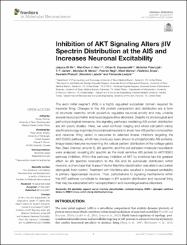| dc.contributor.author | Di Re, Jessica | |
| dc.contributor.author | Hsu, Wei-Chun J. | |
| dc.contributor.author | Kayasandık, Cihan Bilge | |
| dc.contributor.author | Fularczyk, Nickolas | |
| dc.contributor.author | James, Thomas F. | |
| dc.contributor.author | Nenov, Miroslav N. | |
| dc.contributor.author | Negi, Pooran | |
| dc.contributor.author | Marosi, Mate | |
| dc.contributor.author | Scala, Federico | |
| dc.contributor.author | Prasad, Saurabh | |
| dc.contributor.author | Labate, Demetrio | |
| dc.contributor.author | Laezza, Fernanda | |
| dc.date.accessioned | 2021-08-04T09:53:02Z | |
| dc.date.available | 2021-08-04T09:53:02Z | |
| dc.date.issued | 2021 | en_US |
| dc.identifier.citation | Di Re, J., Hsu, W. J., Kayasandık, C. B., Fularczyk, N., James, T. F., Nenov, M. N. ... Laezza, F. (2021). Inhibition of AKT signaling alters beta IV spectrin distribution at the AIS and increases neuronal excitability. Frontiers in Molecular Neuroscience, 14. https://dx.doi.org/10.3389/fnmol.2021.643860 | en_US |
| dc.identifier.issn | 1662-5099 | |
| dc.identifier.uri | https://dx.doi.org/10.3389/fnmol.2021.643860 | |
| dc.identifier.uri | https://hdl.handle.net/20.500.12511/7670 | |
| dc.description.abstract | The axon initial segment (AIS) is a highly regulated subcellular domain required for neuronal firing. Changes in the AIS protein composition and distribution are a form of structural plasticity, which powerfully regulates neuronal activity and may underlie several neuropsychiatric and neurodegenerative disorders. Despite its physiological and pathophysiological relevance, the signaling pathways mediating AIS protein distribution are still poorly studied. Here, we used confocal imaging and whole-cell patch clamp electrophysiology in primary hippocampal neurons to study how AIS protein composition and neuronal firing varied in response to selected kinase inhibitors targeting the AKT/GSK3 pathway, which has previously been shown to phosphorylate AIS proteins. Image-based features representing the cellular pattern distribution of the voltage-gated Na+ (Nav) channel, ankyrin G, beta IV spectrin, and the cell-adhesion molecule neurofascin were analyzed, revealing beta IV spectrin as the most sensitive AIS protein to AKT/GSK3 pathway inhibition. Within this pathway, inhibition of AKT by triciribine has the greatest effect on beta IV spectrin localization to the AIS and its subcellular distribution within neurons, a phenotype that Support Vector Machine classification was able to accurately distinguish from control. Treatment with triciribine also resulted in increased excitability in primary hippocampal neurons. Thus, perturbations to signaling mechanisms within the AKT pathway contribute to changes in beta IV spectrin distribution and neuronal firing that may be associated with neuropsychiatric and neurodegenerative disorders. | en_US |
| dc.description.sponsorship | United States Department of Health & Human Services National Institutes of Health (NIH) - USA ; National Science Foundation (NSF) | en_US |
| dc.language.iso | eng | en_US |
| dc.publisher | Frontiers Media S.A. | en_US |
| dc.rights | info:eu-repo/semantics/openAccess | en_US |
| dc.rights | Attribution 4.0 International | * |
| dc.rights.uri | https://creativecommons.org/licenses/by/4.0/ | * |
| dc.subject | AIS Plasticity | en_US |
| dc.subject | Support Vector Machine Classification | en_US |
| dc.subject | Confocal Imaging | en_US |
| dc.subject | GSK3 – Glycogen Synthase Kinase 3 | en_US |
| dc.subject | WEE1 Kinase | en_US |
| dc.subject | Patch Clamp Electrophysiology | en_US |
| dc.title | Inhibition of AKT signaling alters beta IV spectrin distribution at the AIS and increases neuronal excitability | en_US |
| dc.type | article | en_US |
| dc.relation.ispartof | Frontiers in Molecular Neuroscience | en_US |
| dc.department | İstanbul Medipol Üniversitesi, Mühendislik ve Doğa Bilimleri Fakültesi, Bilgisayar Mühendisliği Bölümü | en_US |
| dc.identifier.volume | 14 | en_US |
| dc.relation.publicationcategory | Makale - Uluslararası Hakemli Dergi - Kurum Öğretim Elemanı | en_US |
| dc.identifier.doi | 10.3389/fnmol.2021.643860 | en_US |
| dc.identifier.wosquality | Q1 | en_US |
| dc.identifier.scopusquality | Q1 | en_US |



















